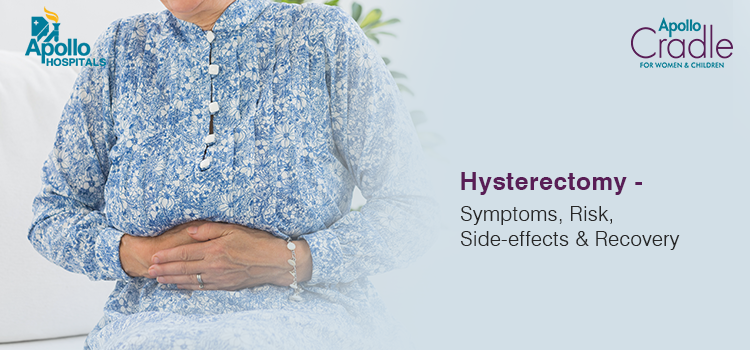A hysterectomy is a surgical procedure whereby the uterus is removed.
Types of Hysterectomy (based on what’s removed):
- Partial- removes the uterus but leaves the cervix intact.
- Standard- removes both uterus and cervix.
- Total- removes the uterus, cervix, and one or both ovaries and fallopian tubes.
Hysterectomies can be performed through either the abdomen or the vagina. They may be performed using laparoscopic techniques or robotic assistance.
Symptoms
The conditions necessitating hysterectomy include:
- Abnormal vaginal bleeding
- Uterine fibroids
- Uterine prolapse (the uterus slides into the vaginal canal from its normal position)
- Cancerof the uterus, cervix, or ovaries
- Endometriosis
- Chronic pelvic pain
- Chronic uterine infection
- Thickening of the uterus (Adenomyosis)
Risks
A major surgery, hysterectomy does have a set of risk factors such as:
- Excess blood loss or internal haemorrhage
- Blood clots
- Infection
- Side effects caused by anaesthesia
- Injury to the genitourinary and gastrointestinal tract
- Nerve injury
- Risks are higher in obese or diabetic women
It is important to note that such risks are common to most surgeries. They don’t mean undergoing a hysterectomy is unsafe.
READ: Hysterectomy: Types, Surgery, Benefits and Risks
Side effects
Short-term
Physical effects
- vaginal discharge
- pain, swelling or bruising at the site of the incision
- burning or itching near the incision
- numbness around the incision or down the leg
A total hysterectomy that includes removal of the ovaries would result in immediate menopause causing the following associated effects:
- hot flashes
- night sweats
- vaginal dryness
- insomnia
Emotional side effects
The uterus is essential for pregnancy. Its removal rules out chances of the same, which can be a tough pill for many women to follow. The stopping of menstruation may also be accompanied by a sense of loss.
Long-term
The stopping of periods and the inability to become pregnant are the permanent effects of undergoing a hysterectomy.
Other long term effects include:
1) Organ prolapse
- Pelvic organ prolapse
- Vaginal prolapse
- Bowel or bladder prolapse
2) Impact on sex life
Sexual side effects of hysterectomy induced menopause can include:
- vaginal dryness
- pain during sex
- decreased sex drive
Recovery
A hysterectomy is followed by a brief recovery period in the gynaecology hospital. The recovery time at home depends on the procedure one’s undergone. The general recovery outlook for the different types of hysterectomies is as follows:
| Procedure | Duration of stay at gynaecology hospital | Recovery period at home |
| Abdominal hysterectomy | 2-3 days | 6-8 weeks |
| Laparoscopic-assisted vaginal hysterectomy (LAVH) | Discharged the same or next day
|
2 weeks.
Sexual abstinence till 6 weeks |
| Laparoscopic supracervical hysterectomy (LSH). | Discharged the same or next day | 6 days-2 weeks |
| Robotic hysterectomy | Discharged the same or next day | 2 weeks.
Sexual abstinence till 6 weeks |
Concluding tip
Hysterectomy is a major surgery with significant implications for the maternal aspects of a woman’s life. While it is safe and effective, it does come with its set of risks and side-effects. This makes it important to choose the right gynaecology hospital to avail of the best surgical and post-surgical care. Renowned gynaecology hospitals such as Apollo Cradle, known for their top-notch infrastructure, equipment and super-speciality staff, are ideal options to go in for.



